Africa · Attractions · Egypt · Going Out · Regions
5 lesser-known pyramids in Egypt
The Great Pyramids of Giza are one of the world’s defining architectural achievements; one of the wonders of the ancient world, and a dazzling feat of architectural genius. The Great Pyramid and its two cousins at the Giza pyramid complex is a must-see Egyptian landmark. Along with the enigmatic Sphinx and other smaller tombs and monuments around, the splendor of that iconic plateau is amazingly reviled. However, there are some other major pyramid complexes in Egypt which tell another chapter of the story of tomb-building and artwork in ancient Egypt. Continue reading to learn more about five of them.
1. The Step Pyramid of Djoser
Location: Saqqara, Al Badrashin, near Giza Pyramids
Pharaoh: Djoser (or Zoser)
Era: Between 2630 BC and 2611 BC
It is famous enough that plenty of people have heard of it, yet have already visited it. It is a stunning departure from the common structures that came before it. Therefore, it’s considered as the earliest-known example of large-scale and cut-stone construction. Prior to Djoser, Ancient Egyptian burials have occurred in ancient tombs of mud-brick with sloping sides and mastabas. Then comes The Step Pyramid by 2667 – 2648 BC to represent multiple mastabas stacked on top of each other. Yet, the structure was not that simple! Archaeologists believe that the entire design of Djoser may echo the Egyptian crown of the era, as well as, it has been intended to facilitate the king’s ascension to join the North Star.
 The first step of Djoser is M1, followed by M2 step – with an expansion on all sides, and then comes an M3 step – with an expansion on just the east side. The original four-layer structure, P1, was then further expanded into P2, the same shape and size of the Step Pyramid today.
The entire complex of Djoser is surrounded by the Great Trench, a huge trench of 750 meters long and 40 meters wide. The Step Pyramid of Djoser represents a revolution in part; as it represents a huge leap forward over everything that had come before. Also, it has affected the Egyptian pyramid construction for the following hundreds of years.
2. Meidum Pyramid – Sneferu Pyramid
Location: Meidum area, North East of Medinat Al-Fayoum, Giza
Pharaoh: Sneferu
Era: 2637-2613 BC
It is believed to be the second pyramid built after The Step Pyramid of Djoser. The original plan for The Meidum Pyramid was to build a seven-step pyramid, yet The Meidum was later rebuilt for an eight-step base. The architect, the successor of Imhotep, the builder of Djoser, later decided to use a limestone fill to transform Meidum from a step pyramid to an “actual pyramid”. Where the initial foundation and modifications rested directly on bedrock, the final limestone layer was laid horizontally rather than angling towards the pyramid’s core and rested on the sand. This is how these accomplished modifications compromised the structure. Yet, the Meidum pyramid is believed to have collapsed during a downpour while still under construction.
The first step of Djoser is M1, followed by M2 step – with an expansion on all sides, and then comes an M3 step – with an expansion on just the east side. The original four-layer structure, P1, was then further expanded into P2, the same shape and size of the Step Pyramid today.
The entire complex of Djoser is surrounded by the Great Trench, a huge trench of 750 meters long and 40 meters wide. The Step Pyramid of Djoser represents a revolution in part; as it represents a huge leap forward over everything that had come before. Also, it has affected the Egyptian pyramid construction for the following hundreds of years.
2. Meidum Pyramid – Sneferu Pyramid
Location: Meidum area, North East of Medinat Al-Fayoum, Giza
Pharaoh: Sneferu
Era: 2637-2613 BC
It is believed to be the second pyramid built after The Step Pyramid of Djoser. The original plan for The Meidum Pyramid was to build a seven-step pyramid, yet The Meidum was later rebuilt for an eight-step base. The architect, the successor of Imhotep, the builder of Djoser, later decided to use a limestone fill to transform Meidum from a step pyramid to an “actual pyramid”. Where the initial foundation and modifications rested directly on bedrock, the final limestone layer was laid horizontally rather than angling towards the pyramid’s core and rested on the sand. This is how these accomplished modifications compromised the structure. Yet, the Meidum pyramid is believed to have collapsed during a downpour while still under construction.
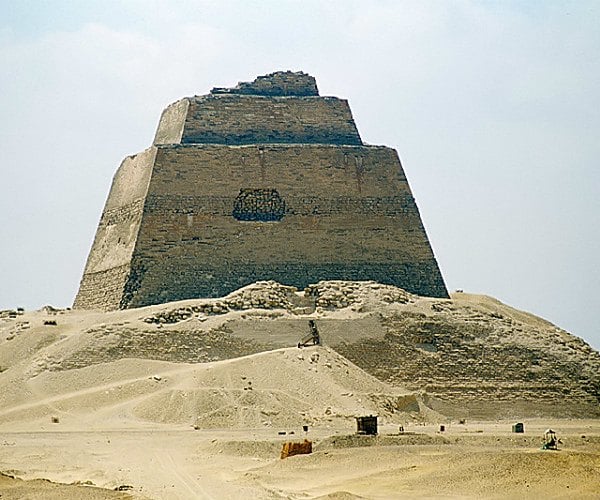 The Meidum Pyramid is the first of three pyramids built by Sneferu; it may be the first to feature an actual burial chamber at its core. Its design makes of it evidence that the ancient Egyptians were exploring a more advanced form of pyramid construction quite rapidly after the success of the Step Pyramid.
3. Pyramid of Sahure
Location: near Abusir – between Saqqara and the Giza Plateau
Pharaoh: Sahure
Era: Late 26th century BC to early 25th century BC
Sahure Pyramid is located at Abusir. It was built by King Sahure, the 2nd king of the 5th dynasty who ruled Egypt for some 12 years. It may look like little more than a rubble pile, but it’s quite important landmark! While the pyramid of Sahure is poorly preserved, the complex to which it belongs represents the final phase of a layout system that would remain unchanged for more than 300 years. The complex consists of a pyramid, mortuary temple, and a roofed causeway. The core of the Sahure pyramid is formed with roughly shaped locally quarried limestone blocks. Sahure’s complex had a clear impact on the evolution of Egyptian funerary practices and art for centuries to come.
The Meidum Pyramid is the first of three pyramids built by Sneferu; it may be the first to feature an actual burial chamber at its core. Its design makes of it evidence that the ancient Egyptians were exploring a more advanced form of pyramid construction quite rapidly after the success of the Step Pyramid.
3. Pyramid of Sahure
Location: near Abusir – between Saqqara and the Giza Plateau
Pharaoh: Sahure
Era: Late 26th century BC to early 25th century BC
Sahure Pyramid is located at Abusir. It was built by King Sahure, the 2nd king of the 5th dynasty who ruled Egypt for some 12 years. It may look like little more than a rubble pile, but it’s quite important landmark! While the pyramid of Sahure is poorly preserved, the complex to which it belongs represents the final phase of a layout system that would remain unchanged for more than 300 years. The complex consists of a pyramid, mortuary temple, and a roofed causeway. The core of the Sahure pyramid is formed with roughly shaped locally quarried limestone blocks. Sahure’s complex had a clear impact on the evolution of Egyptian funerary practices and art for centuries to come.
 4. Pyramid of Neferirkare
Location: Abusir – between Giza and Saqqara
Pharaoh: NeferirkareKakai
Era: in the 25th century BC
Neferirkare is one of the fifth dynasty pharaohs in the Old Kingdom of Ancient Egypt. Like his predecessor Sahure, Neferirkare chose to build his pyramid at Abusir. The pyramid complex is composed of a pyramid and mortuary temple. While King Neferirkare did not manage to complete the causeway and valley temple, the complex was finished by his son, Niuserre.
4. Pyramid of Neferirkare
Location: Abusir – between Giza and Saqqara
Pharaoh: NeferirkareKakai
Era: in the 25th century BC
Neferirkare is one of the fifth dynasty pharaohs in the Old Kingdom of Ancient Egypt. Like his predecessor Sahure, Neferirkare chose to build his pyramid at Abusir. The pyramid complex is composed of a pyramid and mortuary temple. While King Neferirkare did not manage to complete the causeway and valley temple, the complex was finished by his son, Niuserre.
 The Pyramid of Neferirkare was originally constructed as a step pyramid, even though they had moved on to true pyramids by this era. The limestone cladding used to convert the pyramid to a true pyramid was done cheaply, that’s why it has collapsed. Although there is no sign of a satellite pyramid of King Neferirkare, the pyramid of Khentkhaus II (his wife) to the south of his pyramid started out as the Neferirkare satellite pyramid, which was then adapted to form The Khentkhaus II complex.
Neferirkare’s pyramid is an important monument due to the enormous set of papyri that were found adjacent to it – collectively known as the Abusir papyri. The Abusirpapyri represent the earliest known example of the Egyptian hieratic script, which is important for dating other archeological finds. Also, these papyricontain important information on the administration of a Pyramid temple and the duty assignments of the priests in question.
5. Pyramid Complex of Unas
Location: at the opposite corner of Netjerikhet’s complex, near Saqqara, Giza
Pharaoh: Unas (or Wenis)
Era: 24th century BC
It is located in the pyramid field at Saqqara, near Cairo in Egypt. It looks more like a small hill than a royal pyramid! Unas’ Pyramid contains the first example of what is now known as the Pyramid Texts — the religious spells and inscriptions that were used to safeguard the Pharaoh on his journey between this world and the next one.
The Pyramid of Neferirkare was originally constructed as a step pyramid, even though they had moved on to true pyramids by this era. The limestone cladding used to convert the pyramid to a true pyramid was done cheaply, that’s why it has collapsed. Although there is no sign of a satellite pyramid of King Neferirkare, the pyramid of Khentkhaus II (his wife) to the south of his pyramid started out as the Neferirkare satellite pyramid, which was then adapted to form The Khentkhaus II complex.
Neferirkare’s pyramid is an important monument due to the enormous set of papyri that were found adjacent to it – collectively known as the Abusir papyri. The Abusirpapyri represent the earliest known example of the Egyptian hieratic script, which is important for dating other archeological finds. Also, these papyricontain important information on the administration of a Pyramid temple and the duty assignments of the priests in question.
5. Pyramid Complex of Unas
Location: at the opposite corner of Netjerikhet’s complex, near Saqqara, Giza
Pharaoh: Unas (or Wenis)
Era: 24th century BC
It is located in the pyramid field at Saqqara, near Cairo in Egypt. It looks more like a small hill than a royal pyramid! Unas’ Pyramid contains the first example of what is now known as the Pyramid Texts — the religious spells and inscriptions that were used to safeguard the Pharaoh on his journey between this world and the next one.
 These spells contained within covered every aspect of the Pharaoh’s journey, from spells of protection for his body to those intended to call upon the gods for aid. They detail the rituals that were used by the priests to consecrate the body, including the critical “Opening of the Mouth” ceremony, which was believed to be essential to the deceased’s ability to eat and drink in the afterlife. Moreover, the walls of the burial chamber – at the Unas Complex – are covered with hieroglyphs; some magicformulas that are supposed to help the king’s soul defeat enemies and difficulties on his way to the afterlife.
Although Unas’ pyramid texts are the smallest of all the Pharaohs, it provided the standard all later tombs followed. There’s always a sense of the religious meaning behind these words, they intended for their spells to protect and guide the soul of the Pharaoh throughout eternity.
How many pyramids are there?
There is an estimated range from 93 to 138 pyramids in Egypt. Most of the main pyramids had “queens” and/or supplementary pyramids built close to them, yet it is hard to determine whether a pile of rocks is the remains of a pyramid or just a pile of rocks!
Whether you have visited Egypt before or not, you still need one more visit to discover its hidden treasures and unique landmarks.
Sherif Khalil is Owner of Dunes & Beyond. Dunes & Beyond offers luxury tours, Nile cruises and desert safaris in Egypt.
If you would like to be a guest blogger on A Luxury Travel Blog in order to raise your profile, please contact us.
These spells contained within covered every aspect of the Pharaoh’s journey, from spells of protection for his body to those intended to call upon the gods for aid. They detail the rituals that were used by the priests to consecrate the body, including the critical “Opening of the Mouth” ceremony, which was believed to be essential to the deceased’s ability to eat and drink in the afterlife. Moreover, the walls of the burial chamber – at the Unas Complex – are covered with hieroglyphs; some magicformulas that are supposed to help the king’s soul defeat enemies and difficulties on his way to the afterlife.
Although Unas’ pyramid texts are the smallest of all the Pharaohs, it provided the standard all later tombs followed. There’s always a sense of the religious meaning behind these words, they intended for their spells to protect and guide the soul of the Pharaoh throughout eternity.
How many pyramids are there?
There is an estimated range from 93 to 138 pyramids in Egypt. Most of the main pyramids had “queens” and/or supplementary pyramids built close to them, yet it is hard to determine whether a pile of rocks is the remains of a pyramid or just a pile of rocks!
Whether you have visited Egypt before or not, you still need one more visit to discover its hidden treasures and unique landmarks.
Sherif Khalil is Owner of Dunes & Beyond. Dunes & Beyond offers luxury tours, Nile cruises and desert safaris in Egypt.
If you would like to be a guest blogger on A Luxury Travel Blog in order to raise your profile, please contact us.
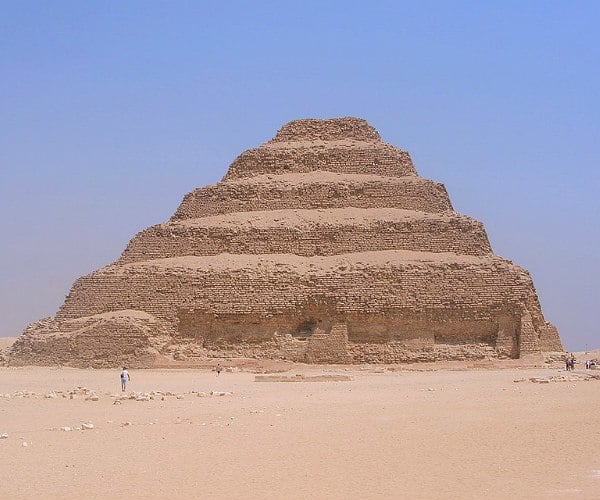 The first step of Djoser is M1, followed by M2 step – with an expansion on all sides, and then comes an M3 step – with an expansion on just the east side. The original four-layer structure, P1, was then further expanded into P2, the same shape and size of the Step Pyramid today.
The entire complex of Djoser is surrounded by the Great Trench, a huge trench of 750 meters long and 40 meters wide. The Step Pyramid of Djoser represents a revolution in part; as it represents a huge leap forward over everything that had come before. Also, it has affected the Egyptian pyramid construction for the following hundreds of years.
2. Meidum Pyramid – Sneferu Pyramid
Location: Meidum area, North East of Medinat Al-Fayoum, Giza
Pharaoh: Sneferu
Era: 2637-2613 BC
It is believed to be the second pyramid built after The Step Pyramid of Djoser. The original plan for The Meidum Pyramid was to build a seven-step pyramid, yet The Meidum was later rebuilt for an eight-step base. The architect, the successor of Imhotep, the builder of Djoser, later decided to use a limestone fill to transform Meidum from a step pyramid to an “actual pyramid”. Where the initial foundation and modifications rested directly on bedrock, the final limestone layer was laid horizontally rather than angling towards the pyramid’s core and rested on the sand. This is how these accomplished modifications compromised the structure. Yet, the Meidum pyramid is believed to have collapsed during a downpour while still under construction.
The first step of Djoser is M1, followed by M2 step – with an expansion on all sides, and then comes an M3 step – with an expansion on just the east side. The original four-layer structure, P1, was then further expanded into P2, the same shape and size of the Step Pyramid today.
The entire complex of Djoser is surrounded by the Great Trench, a huge trench of 750 meters long and 40 meters wide. The Step Pyramid of Djoser represents a revolution in part; as it represents a huge leap forward over everything that had come before. Also, it has affected the Egyptian pyramid construction for the following hundreds of years.
2. Meidum Pyramid – Sneferu Pyramid
Location: Meidum area, North East of Medinat Al-Fayoum, Giza
Pharaoh: Sneferu
Era: 2637-2613 BC
It is believed to be the second pyramid built after The Step Pyramid of Djoser. The original plan for The Meidum Pyramid was to build a seven-step pyramid, yet The Meidum was later rebuilt for an eight-step base. The architect, the successor of Imhotep, the builder of Djoser, later decided to use a limestone fill to transform Meidum from a step pyramid to an “actual pyramid”. Where the initial foundation and modifications rested directly on bedrock, the final limestone layer was laid horizontally rather than angling towards the pyramid’s core and rested on the sand. This is how these accomplished modifications compromised the structure. Yet, the Meidum pyramid is believed to have collapsed during a downpour while still under construction.
 The Meidum Pyramid is the first of three pyramids built by Sneferu; it may be the first to feature an actual burial chamber at its core. Its design makes of it evidence that the ancient Egyptians were exploring a more advanced form of pyramid construction quite rapidly after the success of the Step Pyramid.
3. Pyramid of Sahure
Location: near Abusir – between Saqqara and the Giza Plateau
Pharaoh: Sahure
Era: Late 26th century BC to early 25th century BC
Sahure Pyramid is located at Abusir. It was built by King Sahure, the 2nd king of the 5th dynasty who ruled Egypt for some 12 years. It may look like little more than a rubble pile, but it’s quite important landmark! While the pyramid of Sahure is poorly preserved, the complex to which it belongs represents the final phase of a layout system that would remain unchanged for more than 300 years. The complex consists of a pyramid, mortuary temple, and a roofed causeway. The core of the Sahure pyramid is formed with roughly shaped locally quarried limestone blocks. Sahure’s complex had a clear impact on the evolution of Egyptian funerary practices and art for centuries to come.
The Meidum Pyramid is the first of three pyramids built by Sneferu; it may be the first to feature an actual burial chamber at its core. Its design makes of it evidence that the ancient Egyptians were exploring a more advanced form of pyramid construction quite rapidly after the success of the Step Pyramid.
3. Pyramid of Sahure
Location: near Abusir – between Saqqara and the Giza Plateau
Pharaoh: Sahure
Era: Late 26th century BC to early 25th century BC
Sahure Pyramid is located at Abusir. It was built by King Sahure, the 2nd king of the 5th dynasty who ruled Egypt for some 12 years. It may look like little more than a rubble pile, but it’s quite important landmark! While the pyramid of Sahure is poorly preserved, the complex to which it belongs represents the final phase of a layout system that would remain unchanged for more than 300 years. The complex consists of a pyramid, mortuary temple, and a roofed causeway. The core of the Sahure pyramid is formed with roughly shaped locally quarried limestone blocks. Sahure’s complex had a clear impact on the evolution of Egyptian funerary practices and art for centuries to come.
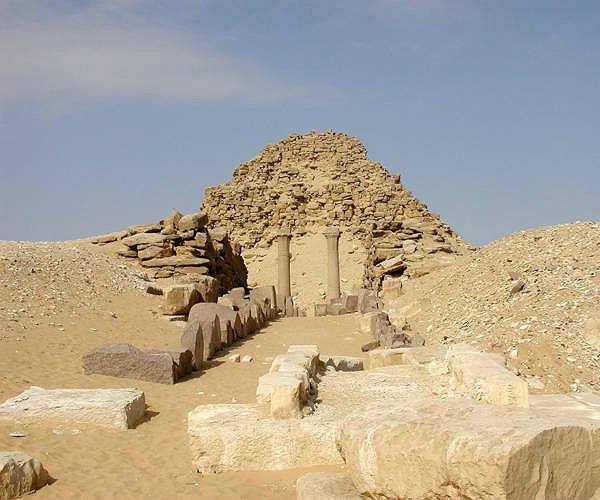 4. Pyramid of Neferirkare
Location: Abusir – between Giza and Saqqara
Pharaoh: NeferirkareKakai
Era: in the 25th century BC
Neferirkare is one of the fifth dynasty pharaohs in the Old Kingdom of Ancient Egypt. Like his predecessor Sahure, Neferirkare chose to build his pyramid at Abusir. The pyramid complex is composed of a pyramid and mortuary temple. While King Neferirkare did not manage to complete the causeway and valley temple, the complex was finished by his son, Niuserre.
4. Pyramid of Neferirkare
Location: Abusir – between Giza and Saqqara
Pharaoh: NeferirkareKakai
Era: in the 25th century BC
Neferirkare is one of the fifth dynasty pharaohs in the Old Kingdom of Ancient Egypt. Like his predecessor Sahure, Neferirkare chose to build his pyramid at Abusir. The pyramid complex is composed of a pyramid and mortuary temple. While King Neferirkare did not manage to complete the causeway and valley temple, the complex was finished by his son, Niuserre.
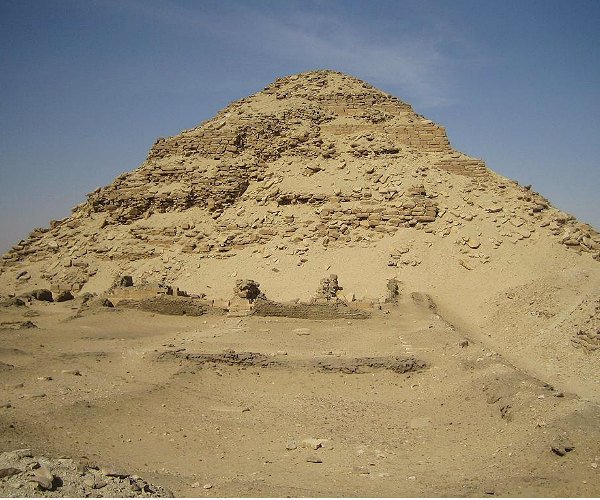 The Pyramid of Neferirkare was originally constructed as a step pyramid, even though they had moved on to true pyramids by this era. The limestone cladding used to convert the pyramid to a true pyramid was done cheaply, that’s why it has collapsed. Although there is no sign of a satellite pyramid of King Neferirkare, the pyramid of Khentkhaus II (his wife) to the south of his pyramid started out as the Neferirkare satellite pyramid, which was then adapted to form The Khentkhaus II complex.
Neferirkare’s pyramid is an important monument due to the enormous set of papyri that were found adjacent to it – collectively known as the Abusir papyri. The Abusirpapyri represent the earliest known example of the Egyptian hieratic script, which is important for dating other archeological finds. Also, these papyricontain important information on the administration of a Pyramid temple and the duty assignments of the priests in question.
5. Pyramid Complex of Unas
Location: at the opposite corner of Netjerikhet’s complex, near Saqqara, Giza
Pharaoh: Unas (or Wenis)
Era: 24th century BC
It is located in the pyramid field at Saqqara, near Cairo in Egypt. It looks more like a small hill than a royal pyramid! Unas’ Pyramid contains the first example of what is now known as the Pyramid Texts — the religious spells and inscriptions that were used to safeguard the Pharaoh on his journey between this world and the next one.
The Pyramid of Neferirkare was originally constructed as a step pyramid, even though they had moved on to true pyramids by this era. The limestone cladding used to convert the pyramid to a true pyramid was done cheaply, that’s why it has collapsed. Although there is no sign of a satellite pyramid of King Neferirkare, the pyramid of Khentkhaus II (his wife) to the south of his pyramid started out as the Neferirkare satellite pyramid, which was then adapted to form The Khentkhaus II complex.
Neferirkare’s pyramid is an important monument due to the enormous set of papyri that were found adjacent to it – collectively known as the Abusir papyri. The Abusirpapyri represent the earliest known example of the Egyptian hieratic script, which is important for dating other archeological finds. Also, these papyricontain important information on the administration of a Pyramid temple and the duty assignments of the priests in question.
5. Pyramid Complex of Unas
Location: at the opposite corner of Netjerikhet’s complex, near Saqqara, Giza
Pharaoh: Unas (or Wenis)
Era: 24th century BC
It is located in the pyramid field at Saqqara, near Cairo in Egypt. It looks more like a small hill than a royal pyramid! Unas’ Pyramid contains the first example of what is now known as the Pyramid Texts — the religious spells and inscriptions that were used to safeguard the Pharaoh on his journey between this world and the next one.
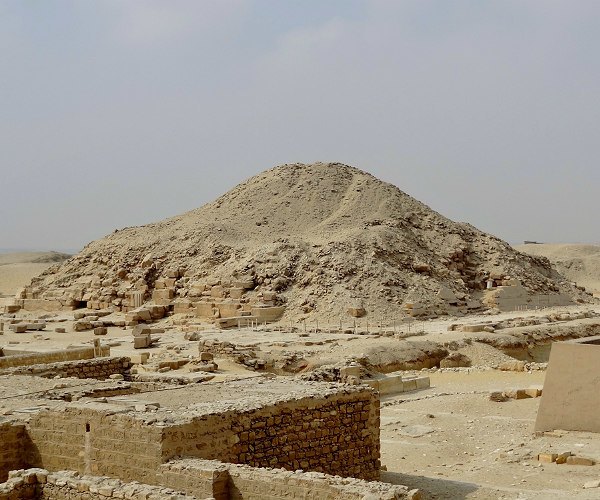 These spells contained within covered every aspect of the Pharaoh’s journey, from spells of protection for his body to those intended to call upon the gods for aid. They detail the rituals that were used by the priests to consecrate the body, including the critical “Opening of the Mouth” ceremony, which was believed to be essential to the deceased’s ability to eat and drink in the afterlife. Moreover, the walls of the burial chamber – at the Unas Complex – are covered with hieroglyphs; some magicformulas that are supposed to help the king’s soul defeat enemies and difficulties on his way to the afterlife.
Although Unas’ pyramid texts are the smallest of all the Pharaohs, it provided the standard all later tombs followed. There’s always a sense of the religious meaning behind these words, they intended for their spells to protect and guide the soul of the Pharaoh throughout eternity.
How many pyramids are there?
There is an estimated range from 93 to 138 pyramids in Egypt. Most of the main pyramids had “queens” and/or supplementary pyramids built close to them, yet it is hard to determine whether a pile of rocks is the remains of a pyramid or just a pile of rocks!
Whether you have visited Egypt before or not, you still need one more visit to discover its hidden treasures and unique landmarks.
Sherif Khalil is Owner of Dunes & Beyond. Dunes & Beyond offers luxury tours, Nile cruises and desert safaris in Egypt.
If you would like to be a guest blogger on A Luxury Travel Blog in order to raise your profile, please contact us.
These spells contained within covered every aspect of the Pharaoh’s journey, from spells of protection for his body to those intended to call upon the gods for aid. They detail the rituals that were used by the priests to consecrate the body, including the critical “Opening of the Mouth” ceremony, which was believed to be essential to the deceased’s ability to eat and drink in the afterlife. Moreover, the walls of the burial chamber – at the Unas Complex – are covered with hieroglyphs; some magicformulas that are supposed to help the king’s soul defeat enemies and difficulties on his way to the afterlife.
Although Unas’ pyramid texts are the smallest of all the Pharaohs, it provided the standard all later tombs followed. There’s always a sense of the religious meaning behind these words, they intended for their spells to protect and guide the soul of the Pharaoh throughout eternity.
How many pyramids are there?
There is an estimated range from 93 to 138 pyramids in Egypt. Most of the main pyramids had “queens” and/or supplementary pyramids built close to them, yet it is hard to determine whether a pile of rocks is the remains of a pyramid or just a pile of rocks!
Whether you have visited Egypt before or not, you still need one more visit to discover its hidden treasures and unique landmarks.
Sherif Khalil is Owner of Dunes & Beyond. Dunes & Beyond offers luxury tours, Nile cruises and desert safaris in Egypt.
If you would like to be a guest blogger on A Luxury Travel Blog in order to raise your profile, please contact us.Did you enjoy this article?
Receive similar content direct to your inbox.


All of these pyramids are from times so long ago and do different from our own that I find it quite difficult to make a connection with the mindset of the people who laboured to build them.
I’ve only visited the well known pyramids at Giza. Luckily I invested in a brilliant and fascinating guide who really brought those pyramids to life.
So what I am saying is that if you’re going to make the effort to see these lesser known pyramids make sure that you invest in a guide who knows his stuff. It will add so much to your enjoyment of these historic constructions.
Totally agree, the great guide can make a big difference
What we overlook nowadays is how ambitious all these construction projects were at the time. We forget that there was no technology to help with the building. It was largely done by manual labour often in blistering heat. All of these pyramids would have taken years and years to construct.
Yes, it’s quite thought-provoking to think how much effort the Ancient Egyptians put into these pyramids and I never knew that there were this many of them.
This must have been a very civilised and well-organised society that had the spare cash and manpower to commit to such huge projects taking many years. When you think how much doubt Britain has about HS2 which ought to bring huge economic benefits to both North and South, you begin to realise what immense commitment the Egyptian people had to these pyramid projects.
I’ve been to Egypt a couple of times, done both Cairo and Luxor, but I feel that I’ve only just scratched the surface. I’m keen to visit again and to try to get inside the minds of the Ancient Egyptians. I find the ideas behind all the rituals, such as the Opening of the Mouth ceremony all very intriguing. It’s just amazing how much imagination and preparation that they put in place for a Pharoah’s after-life which they thought would last for eternity. You have to ask whether all the people believed in these complicated ideas or did they just go along with what their elders ad betters told them to believe.
That is rights, most of the tourists visiting Egypt only see the highlights, there are tens and may be hundreds of other fascinating sites full of ancients treasures.
It’s fascinating to learn more about the individual pyramids. When I think about Egypt, I do tend to just group all of them together as ‘the pyramids’, without knowing any details on the vast majority. It’s Giza, the Sphinx and the likes of Khufu at Giza, given it’s the largest, that get the most attention. It’s still hard to imagine how they managed such feats back then. Phenomenal but absolutely back breaking work and it must have been soul destroying if they were damaged by accidents, the weather or during modifications, like with the collapse of Meidum during construction. It’s a shame the Pyramid of Neferirkare collapsed too, I’m sure there’s a moral of the story there about not using cheap materials and skimping on construction!